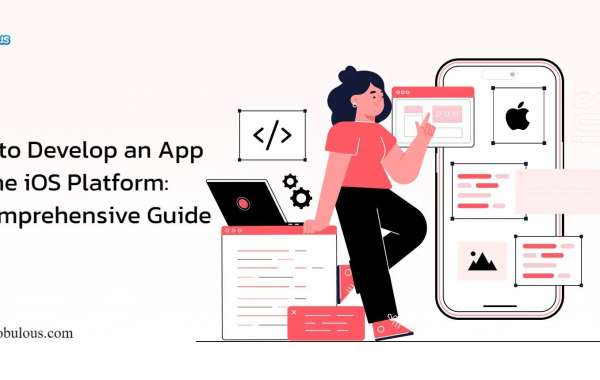The development of an iOS app is a rewarding journey that demands a well-structured approach. With Apple's robust ecosystem and ever-growing user base, creating an iOS app can open doors to new opportunities. However, the process is intricate, requiring detailed planning, design, coding, and testing. This guide will walk you through every step of iOS app development, from conception to deployment on the App Store.
Understanding the iOS Development Environment
- The iOS Ecosystem: Why Choose iOS?
The iOS platform is known for its stability, security, and user-friendly interface. Apple’s devices, including the iPhone, iPad, and iPod Touch, offer a unified environment for developers. By choosing iOS, developers can target a demographic that values quality, consistency, and premium experiences. Moreover, iOS users tend to spend more on apps compared to their Android counterparts, making it a lucrative market for app developers.
- Setting Up Your Development Environment
Before diving into coding, it's essential to set up the right tools. Here’s what you need:
- Xcode: Xcode is Apple's integrated development environment (IDE) for macOS. It includes everything needed to create apps for all Apple platforms. Xcode provides a complete suite of tools for developers to write, compile, test, and debug their iOS applications.
- Swift and Objective-C: Swift is the modern programming language developed by Apple for iOS app development. It is preferred for its readability, speed, and safety. Objective-C is the older language still used in many legacy applications. Understanding both can be beneficial, although Swift is generally recommended for new projects.
- Simulator: Xcode’s iOS Simulator allows you to test your app on a variety of virtual devices before deploying it to a physical device.
- iOS SDK and APIs
The iOS Software Development Kit (SDK) includes a set of tools, libraries, and APIs (Application Programming Interfaces) to develop apps. Familiarizing yourself with these components is crucial for leveraging iOS's full potential.
- UIKit: This framework provides the necessary infrastructure for implementing graphical, event-driven apps in iOS.
- Core Data: Essential for managing the model layer objects in your app, Core Data allows you to save the app’s permanent data for offline use.
- Core Graphics and Core Animation: These frameworks help in creating 2D and 3D visual effects, which are fundamental in designing engaging user interfaces.
Planning Your iOS App Development
- Define Your App's Purpose and Target Audience
The first step in any iPhone app development process is to clearly define the app's purpose and target audience. This clarity will guide every decision you make throughout the development process.
- Market Research: Conduct thorough research to understand the needs of your target audience. This research should inform the features, design, and functionality of your app.
- User Personas: Create detailed user personas to represent the different types of users who will interact with your app. Understanding your users will help you design a user experience (UX) that meets their needs.
- Wireframing and Prototyping
Before writing a single line of code, it's essential to create wireframes and prototypes. These tools help visualize the app’s flow and functionality.
- Wireframes: These are basic sketches or digital blueprints of your app. Wireframes focus on structure and layout rather than detailed design. Tools like Sketch, Figma, or Adobe XD can be used to create wireframes.
- Prototypes: A step beyond wireframes, prototypes provide a closer look at the user experience. Interactive prototypes allow you to simulate the user flow and gather feedback before development begins.
- Designing the User Interface (UI)
The design phase is where your app’s visual identity is created. The UI design should align with Apple’s Human Interface Guidelines (HIG) to ensure a seamless experience on iOS devices.
- Design Tools: Tools like Figma, Sketch, and Adobe XD are popular choices for UI design. These tools allow designers to create pixel-perfect mockups of the app.
- Consistency: Consistent design elements such as fonts, colors, and buttons create a cohesive user experience.
Developing Your iOS App
- Writing the Code
Once the planning and design phases are complete, it's time to start coding. Follow these best practices to ensure efficient development:
- Modular Coding: Break down your app into smaller, manageable modules. This makes your code more organized, easier to debug, and scalable.
- Version Control: Use Git or another version control system to manage changes to your code. This allows you to track progress and collaborate with other developers efficiently.
- Code Reviews: Regular code reviews are crucial for maintaining code quality. They help identify bugs, improve code structure, and ensure adherence to coding standards.
- Implementing Key Features
Focus on implementing the core features that define your app. Here are some critical aspects to consider:
- Navigation: Implement smooth and intuitive navigation. iOS users expect fluid transitions and consistent navigation patterns.
- Data Handling: Efficiently manage data using Core Data or other data storage methods. Ensure that data is securely stored and synchronized across devices if necessary.
- APIs and Third-Party Integrations: Many apps require external data or functionality. Implementing APIs or integrating with third-party services can add valuable features to your app.
Testing and Debugging Your iOS App
- Continuous Testing
Testing should be an ongoing process throughout the development lifecycle. Continuous integration and testing ensure that bugs are caught early and fixed promptly.
- Unit Testing: Write unit tests for individual components of your app to ensure they function correctly in isolation.
- UI Testing: Automated UI tests simulate user interactions with your app. This helps identify issues in the user interface and user experience.
- Beta Testing: Use TestFlight to distribute beta versions of your app to testers. Collect feedback and identify potential issues before the official release.
- Debugging
Debugging is an essential part of the development process. Xcode’s debugging tools allow you to monitor your app’s performance and pinpoint issues.
- Breakpoints: Use breakpoints to pause the execution of your code and inspect variables, memory usage, and application flow.
- Crash Logs: Analyze crash logs to identify and fix issues that cause your app to crash.
Get More Info: Comprehensive Guide to Building Mobile Apps for Wearable Devices
Deploying Your iOS App
- App Store Submission
Once your app is tested and ready, the final step is to submit it to the App Store.
- App Store Guidelines: Ensure your app adheres to Apple’s App Store Guidelines. Non-compliance can lead to rejection during the review process.
- App Store Connect: Use App Store Connect to manage your app’s listing, including its name, description, keywords, screenshots, and pricing.
- App Review Process: Apple reviews every app submitted to the App Store. The review process typically takes a few days, so plan accordingly.
- Post-Launch: Monitoring and Updates
The launch of your app is just the beginning. Monitoring user feedback and updating your app regularly is crucial for long-term success.
- Analytics: Implement analytics tools to track user engagement, retention, and other key metrics.
- Updates: Regular updates improve your app’s functionality, fix bugs, and keep it compatible with the latest iOS versions.




